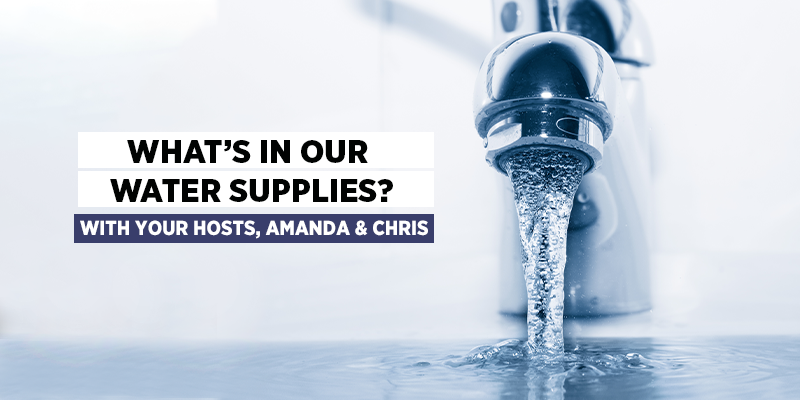
Episode 37: What’s in Our Water Supplies?
Show Notes
In this episode you’ll learn:
-Why it’s so important to pay attention to where your water comes from
-Some common toxins that have been added to our water over the years
-About fluoride and chlorine and why they’re added to tap water
-Some of the adverse effects of drinking tap water
-About the EWG (Environmental Working Group) and how they approach water safety
-How toxins in our water are evaluated for adverse effects
-That every human responds differently to different environments
-The average person number of toxic chemicals in his/her blood and urine
-About multiple contaminants commonly found in tap water
-That there are 316 contaminants in the public water supply, 202 of which are unregulated
-About contaminants found in tap water that exceed the EWG health guidelines
-Some ways that the body naturally excretes toxins
-That the scientific community still debates what amount of these toxins are safe for to be in our water
-Why Chris and I chose to err on the side of caution and avoid unfiltered tap water
-About anthropogenic contaminants and the variety of different risks they pose
-Where some of the EDCs in water come from
-That EDCs in the water can cause adverse reproductive effects in animals and humans
-About the disinfecting products in our water
-About how chlorine affects the water
-That chlorine can lead to an increase in DBPs and affect the microbiome in your gut
-About natural and synthetic estrogens found in our water
-The 3 types of estrogen that are found in pregnant women’s urine and leak into the water supply
-That BPA is an endocrine disruptor and is in our water supply and other commonly used products
-About ways to avoid BPA
-Why we encourage you to filter your water source
-About phthalates and some reasons they’re found in the water in such high amounts
-That heat affects the amount of toxins that are leached into plastic products
-How urinary concentrates affect the water supply
-About some toxins that have been used as pesticides throughout the years
-That many synthetic organic pesticides are found in the water supply
-That water quality and restrictions are much different in Europe than the U.S.
-Common sources of pesticides and how they’re leached into our water
-That coffee is one of the most heavily sprayed crops in the world
-About Fluorinated substances and PFAs
-That the EWG has a database in it’s website where you can search what’s in the water supply for your zip code
-How Brita water filters compare to carbon-based water filters
-About reverse-osmosis water filters and why you need to add minerals to the water
-Some more affordable/effective water filters like the Zero Water filter on Amazon
-That eating a nutrient dense diet can help your body better filter out toxins
-That you can only sweat out certain toxins but it’s still helpful
References:
EWG water database https://www.ewg.org/tapwater/
Berkey carbon-based water filter https://www.amazon.com/Berkey-Gravity-Fed-Filter-Purification-Elements/dp/B00CYW3EVO
Zero Water Filter https://www.amazon.com/ZeroWater-Pitcher-Quality-BPA-Free-Certified/dp/B0073PZ6O0/ref=pd_bxgy_img_2/131-0827737-3858264?_encoding=UTF8&pd_rd_i=B0073PZ6O0&pd_rd_r=6a876114-a766-4538-ba6d-f959be786ae4&pd_rd_w=zOr4Q&pd_rd_wg=I6aQ7&pf_rd_p=ce6c479b-ef53-49a6-845b-bbbf35c28dd3&pf_rd_r=VZH22QKZJH5112BAPK7G&psc=1&refRID=VZH22QKZJH5112BAPK7G
Studies:
-Increased risk of bladder, kidney, and rectal cancers:
https://pubmed.ncbi.nlm.nih.gov/3377557/
https://pubmed.ncbi.nlm.nih.gov/8213753/
https://www.ncbi.nlm.nih.gov/pmc/articles/PMC1694065/
-Reproductive problems like birth defects and low birth weight: https://www.ncbi.nlm.nih.gov/pmc/articles/PMC1739910/pdf/v057p00073.pdf
-Chlorine and chloramine vapors are associated with greater risk of asthma, and may damage the mucosal lining of the respiratory tract: https://oem.bmj.com/content/oemed/60/6/385.full.pdf
-Chlorine has been shown to significantly alter the microbiome by altering bacteria diversity in mice. Unfortunately there hasn’t been many studies in humans to prove this crossover, but usually these rodent studies pave the way for human studies:
Estrogen can disrupt the endocrine system, impair reproductive function, and trigger adverse health effects: https://journals.sagepub.com/doi/10.1080/109158198226675
-Multiple studies have demonstrated a shorter AGD in males exposed to environmental anti-androgens: https://www.sciencedirect.com/topics/veterinary-science-and-veterinary-medicine/anogenital-distance
-Pesticides have been detected in drinking water sources, and some of these compounds are known reproductive toxicants. For example, exposure to some pesticides is associated with low sperm count and adverse pregnancy outcomes in non-human animals and humans: https://www.ncbi.nlm.nih.gov/pmc/articles/PMC7139484/
-This study showed a link between prenatal fluoride exposure and a reduction in IQ: https://ehp.niehs.nih.gov/doi/full/10.1289/EHP655
Additional Sources
https://www.ncbi.nlm.nih.gov/pmc/articles/PMC7139484/
https://www.ewg.org/research/minority-cord-blood-report/bpa-and-other-cord-blood-pollutants

Recent Comments